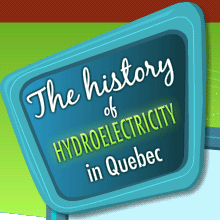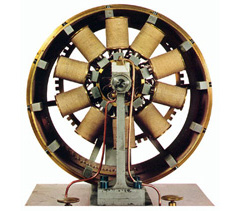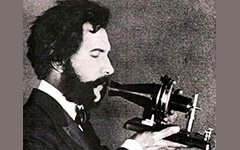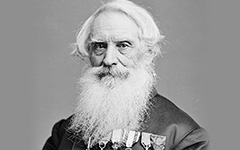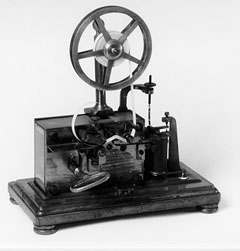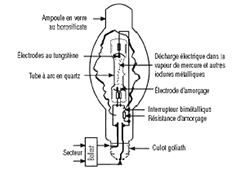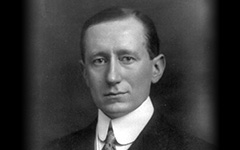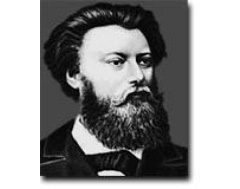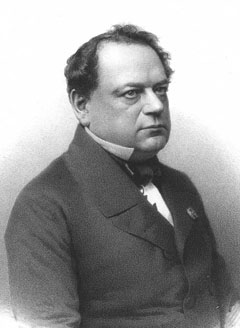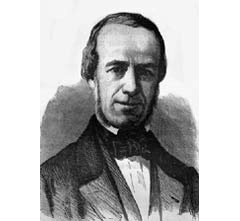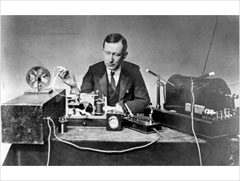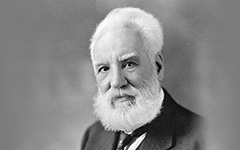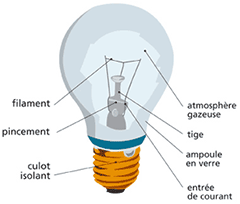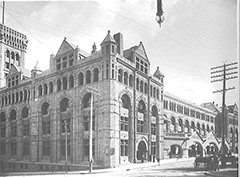Home > Science > The Dawn of Electricity > The First Applications
The First Applications
Lighting
The invention of the Voltaic Pile by Volta served to harness electricity for several uses, including lighting. In 1813, chemist Humphrey Davy succeeded at producing an electric arc that gave off light. However, the two pencil-shaped carbon conductors that produced the electric arc burned very quickly, limiting the use of his invention on a larger scale.
Nearly 70 years would go by before electricity would become a reliable source of lighting accessible to the public. Indeed, in 1878 Russian engineer Pavel Jablochkoff offered a demonstration of his electric arc lamp in the streets of Paris, marking the veritable onset of lighting in city streets. One year later, Thomas Edison perfected the electric light bulb. Use of this incandescent light bulb spread rapidly to homes and businesses.
Motor
The first battery-operated motor was designed in 1834 by German-born Russian, Moritz Jacobi. Four years later, he installed his motor on a boat that sailed seven kilometres along the Neva River in Russia. Another inventor, Robert Davidson, born in Scotland, designed motors to drive presses in plants. In 1837, he designed an electric locomotive. That same year in the United States, inventor Thomas Davenport managed to operate a printing press using an electric motor. During the same era, in France, mechanic Paul Froment produced electric motors to drive machines in industrial applications. Powered by simple batteries, the motors made by these inventors were far from efficient. In 1869, however, the invention of the dynamo, a machine capable of producing much more intense direct current, by Belgian electrician Zénobe Gramme, would serve to develop ever more powerful motors.
Communications
The idea of sending messages by means of electricity dated back to the 18th century and was even raised by Ampère. The very first electric telegraph experiments were conducted as early as 1774. But it was not until 1838 that American painter Samuel Morse patented his concept of electric telegraphy and invented the code that bears his name. During the same year, a first telegraph line was installed between London and Birmingham. Six years later, a line was inaugurated in the United States between Washington and Baltimore.
The transmission of coded text messages through electric wires was only the beginning. The introduction of the first telegraphs heightened scientists' interest in finding a means to transmit the human voice over distances using electric wires. In 1854, in France, inventor Charles Bourseul published the results of his research in an article entitled Transmission électrique de la parole (electric transmission of speech). On February 14, 1876 Alexander Graham Bell filed his patent on the telephone. Three other individuals may also be considered the inventors of the telephone: the Italian, Antonio Meucci, and the Americans, Elisha Gray and Thomas Edison. The telephone was commercialized following the patenting by Bell and experienced great success.
Electromagnetic waves produced naturally were detected by German physicist Heinrich Hertz in 1887.The waves travelled without a physical medium and paved the way for wireless telecommunication. Hertz's research resulted in several scientific discoveries that led to the birth of the radio. Thanks to the work of Russian physicist Alexander Popov, who developed the antenna, and the efforts of French physicist Édouard Branly, in radio guidance, Italian physicist Guglielmo Marconi was able to transmit a message over a wireless telegraph across the Atlantic in 1901. Using waves, he linked Cornwall, England to Newfoundland in Canada. As is the case of the telephone, more than one individual has been recognized as the inventor of the radio. Some historians consider Nikola as the originator of the radio. Native Quebecer and inventor Reginald Fessenden, who completed a first transmission of music over radio waves in 1906, is also a candidate. The first regular radio shows were broadcast in England, Russia and the United States in 1920. Two years later, radio station CKAC in Montreal went on the air.
Appearance of the First Household Appliances
Research carried out by British physicist James Prescott Joule in the 1840s on the connection between heat and energy are at the origin of the first household appliances. Joule noted that the passage of an electric current in a conductor released a great deal of heat. Mastery of this phenomenon paved the way for new applications of electricity. By the end of the 19th century, new electrical appliances began making their appearance: stoves, irons, water heaters and radiators.
